When you’re driving, the dashboard of your automobile transforms into your cockpit. Moreover, the warning signs serve as your essential equipment. You might see a symbol among these that looks like a caterpillar. To keep yourself safe on the road, you must comprehend what it means. We’ll look into the significance of caterpillar warning symbols and meanings in this article. The performance of your car can be monitored by a variety of sensors and warning lights that are included in modern vehicles.
One of these is the caterpillar sign, which is less prevalent than the check engine light or the oil pressure warning. When it does illuminate, though, it does so to draw your attention to a particular problem. Therefore, what exactly does the caterpillar warning symbol mean? We’ll go over some of the most prevalent interpretations of this symbol and what you should do when you see it on the dashboard of your car.
Table of Contents
Explain Caterpillar Warning Symbols And Meanings
Typically, the caterpillar warning indicator is a tiny, vibrant image of a caterpillar crawling along the bottom of your car’s dashboard. This symbol should not be taken lightly because it may represent several urgent problems. Let’s investigate the possible interpretations of this symbol. Here are some typical caterpillar warning signs along with their definitions:
1. Overheated Engine:
Engine overheating is among the most frequent causes of the caterpillar warning symbol to illuminate. This suggests that your engine is operating above the acceptable temperature range. It’s critical to stop, turn off the engine, and let it cool down since carrying on while the engine is overheating can result in serious damage. Verify coolant levels and any leaks that could be the source of the problem.
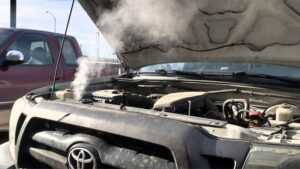
2. Low Levels Of Coolant:
Low coolant levels are another factor that might cause the caterpillar warning symbol to emerge. This may be a sign of engine overheating to come. Your automobile won’t be able to effectively manage the engine temperature if the coolant levels are too low. In this situation, top off your coolant reservoir as soon as you can with the suggested coolant combination.
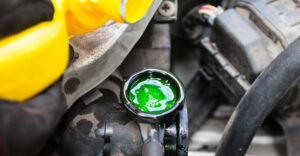
3. Radiator Blockage:
The caterpillar warning indicator can also be activated by a blocked radiator. The radiator cannot efficiently remove heat from the engine when it is blocked. Overheating and potentially expensive engine damage can result from this. Look inside the radiator for obstructions or debris, and if you find any, clean it out or replace it.
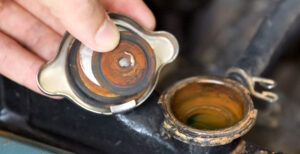
4. Defective Thermostat:
By managing the flow of coolant, the thermostat is in charge of controlling engine temperature. Unpredictable temperature changes brought on by a broken thermostat can result in the caterpillar sign. It’s recommended to have the thermostat replaced by a skilled mechanic if you feel it may be malfunctioning.
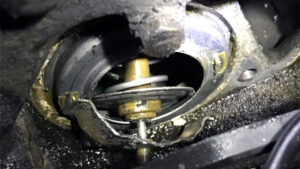
5. Sensor Failure:
The temperature sensor itself may occasionally malfunction, turning on the caterpillar warning symbol. In this instance, the sensor may be feeding the dashboard inaccurate values, which is why the symbol is flashing unnecessarily. A professional diagnostic examination can identify and fix this problem.
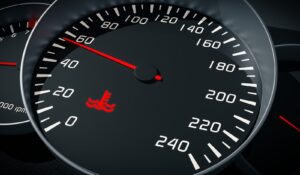
Reasons Behind The Caterpillar Warning Symbols In A Car
After learning about the Caterpillar warning symbols and meanings. Now, let’s delve into some causes of it. The Caterpillar symbols are used in automobiles to inform drivers of specific problems with the diesel particulate filter (DPF) and the vehicle’s emissions system. Here are some common reasons behind these warning symbols.
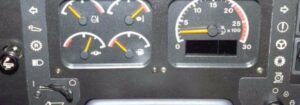
1. Blocked DPF:
A blocked DPF is the most frequent cause of the caterpillar warning light to come on. This happens when the filter loses its efficiency due to being saturated with soot and other particle matter.
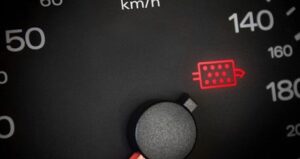
2. Short Journeys:
Your car’s DPF might not have enough time to regenerate and burn off collected soot if you routinely make short trips with it. This may result in warning signs.
3. Low-Quality Fuel:
Low-quality diesel fuel might cause the DPF to accumulate more soot, which will turn on the warning light.

4. Defective Sensors:
Sometimes, defective sensors that monitor the health of the DPF can cause the warning light to turn on.
Caterpillar Warning Symbols: Step-By-Step Guide
A systematic strategy is necessary while dealing with caterpillar warning indicators on your car’s dashboard. We’ll provide clear recommendations for viable strategies to address this problem in the section that follows.
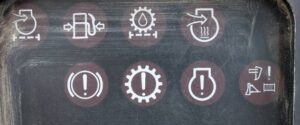
Step 1: Verify The Warning Symbol
It’s crucial to make sure the caterpillar warning symbol on your car’s dashboard refers to the diesel particulate filter (DPF) problem. Although it might differ between car models, this emblem often resembles a caterpillar or an exhaust pipe.
Step 2: Regeneration Process
An automatic DPF regeneration procedure is present in many modern cars and is intended to clean the filter. To start regeneration, take these actions:

- Follow Highway Speed Limits:
Drive your car for 20 to 30 minutes at a steady speed of at least 50 to 60 mph (80 to 96 km/h) on a highway or other major thoroughfare.
- Keep Your Speed Stable:
To maintain a greater exhaust temperature during this journey, try to maintain a constant speed. Avoid idling and making frequent stops.
- Keep An Eye On The Warning Light:
As you drive, pay attention to the caution light. As the regeneration process starts, it should go off. The procedure can, however, take some time to finish.
Step 3: Prevent Quick Trips
Try to steer clear of making lots of quick excursions to prevent the warning light from showing again. Short travels prevent the DPF from getting hot enough to regenerate itself. Take your car on longer trips whenever you can to encourage the filter to naturally clean itself.
Step 4: Utilise High-Quality Fuel
Invest in premium diesel fuel from dependable suppliers. Fewer contaminants are included in higher-grade fuel, which decreases the possibility of soot accumulation in the DPF.

Step 5: Continual Upkeep
Adhere to the maintenance schedule suggested by the manufacturer of your car. DPF inspection and cleaning can be done as part of routine maintenance to ensure the filter stays in good working order.
Step 6: Inspect the Sensors
Consult a qualified mechanic if the warning light continues after trying regeneration or if you think there might be a sensor issue. They can accurately identify the problem using diagnostic instruments.

Step 7: Review The Owner’s Manual
For detailed advice regarding the caterpillar warning symbol and DPF upkeep, always see your car’s owner’s manual. The manual can include additional instructions or safety tips particular to your vehicle.
Step 8: Look For Expert Assistance
Consult a specialist if you have questions about any of the instructions or if the warning light doesn’t go out despite your attempts. A qualified mechanic can identify and fix the problem, ensuring the emissions system in your automobile is working properly.

Therefore, you may properly address the caterpillar warning indicator in your automobile and maintain the functionality of your diesel particulate filter by using the step-by-step instructions provided below. Maintaining the performance of your vehicle and avoiding DPF-related issues require routine maintenance and sensible driving practices.
Repairing Cost To Fix These Warning Symbols
Depending on the underlying problem, repairing a Caterpillar warning symbol in an automobile can be expensive. The diagnosis and repair of simple issues, like a leaky gas cap that causes the sign, may cost roughly $50. On the other hand, more complicated issues with emissions or engine systems might cost hundreds or even thousands of dollars to fix. To ascertain the precise repair cost, a professional diagnosis of the exact issue is required.
Frequently Asked Questions
We’ll look into the meanings of the caterpillar warning signals on your car’s dashboard in this FAQ section. These indicators are essential for the safety and health of your car. Let’s get going!
1. What Does A Car’s Caterpillar Warning Sign Mean?
Ans: An indicator on your car’s dashboard called a caterpillar warning symbol notifies you of potential problems or system failures.
2. Are There Common Warning Images Like Caterpillars?
Ans: No, different auto manufacturers may use different caterpillar warning icons and signify different things. For more information, always refer to your car’s manual.
3. What Common Caterpillar Warning Signs Are There?
Ans: The check engine light, oil pressure warning, battery alarm, and temperature warning are examples of common symbols. Everyone has a distinct meaning.
4. Is It Safe To Keep Driving When A Caterpillar Caution Symbol Is On?
Ans: Depends on the sign and how serious it is. While some problems can wait to be resolved, others need immediate action. Please see your owner’s handbook.
5. Should I Use A Diagnostic Tool To Remove The Caterpillar Warning Symbols?
Ans: It is not advisable to remove symbols without addressing the underlying problem. It won’t fix the issue and could cover up a more significant issue.
6. Where Can I Learn More About The Caterpillar Warning Signs That Apply To My Particular Vehicle?
Ans: For thorough explanations specific to your vehicle, go to the owner’s manual for your car or get in touch with the customer service department of the manufacturer.
Conclusion:
In conclusion, it is crucial for safe driving to comprehend the meanings and significance of various warning indicators in an automobile. These symbols act as essential communication tools by providing key information on the condition of the vehicle. To protect their safety and the longevity of their cars, drivers must get familiar with the caterpillar warning symbols and meanings. Do not hesitate to ask if you require anything, have any questions, or require any assistance. Your car’s well-being is our priority. Driving safely and happily!
![You are currently viewing Caterpillar Warning Symbols And Meanings [Explained]](https://hydraulicsuspension.com/wp-content/uploads/2023/08/mechanic-checking-car-s-oil-level-quality_738298-200.jpg)

![Read more about the article Best Lift Kits For Ford F150 [Top 7]](https://hydraulicsuspension.com/wp-content/uploads/2022/04/3-300x200.jpg)
